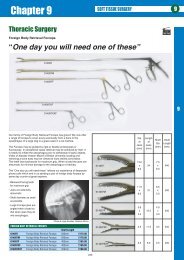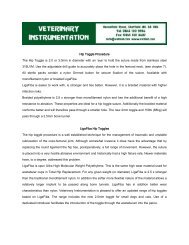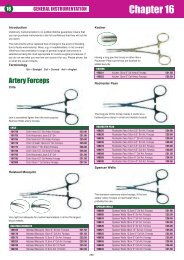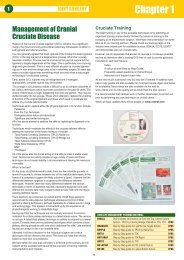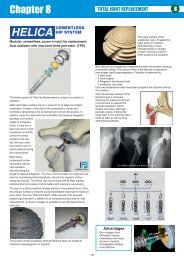Chapter 7 - Veterinary Instrumentation
Chapter 7 - Veterinary Instrumentation
Chapter 7 - Veterinary Instrumentation
Create successful ePaper yourself
Turn your PDF publications into a flip-book with our unique Google optimized e-Paper software.
7 TRAUMA IMPLANTS & INSTRUMENTSLockingPlatesfine threads lock headinto plate.large core to resist bending.coarser threads than headbut still finer than corticalscrew for max bone screwinterface.Standard DCP or Round Hole Plates are held into position by beingtrapped between the head of the screw and the bone. Tightening thescrew pulls the bone up to the plate. When the screw is tight the threadsof the screw pull against the bone holding the plate in position. Thesituation with locking screws and plates is very different. Although thethreads of the screw shaft engage the bone, the interface between boneand screw is not related to attachment of the plate. In locking plates andscrews it is the interface between the screw head and the plate whichattaches the plate to the screw. As the screw is tightened the bonemaintains its position relative to the plate, it is not drawn up to it. Thescrew head engages with the plate. This has a number of implications:Contouring of PlatesWith standard DCPs the plate must be contoured exactly. When thescrews are tightened the bone fragments will be pulled towards the plateand assume the contour of the plate. If the plate is not contoured correctlythe screws will pull the fragments out of alignment. Using a locking plateand screws once the plate is applied the bone fragments will be held inposition relative to one another as is the case with external fixation.Indeed locking plates are sometimes referred to as ‘internal, externalfixation’. Locking plates do not therefore require contouring in the sameway as DCP type plates. This has particular relevance in the TPLOprocedure where contouring the plate is very important and very timeconsuming. If a Standard Locking TPLO Plate fits all TPLO osteotomiesthere are significant savings in terms of time and morbidity.Screw Angulation and NumbersIn order to fit and lock into the plate the screw must be inserted at a fixedangle relative to the hole in the plate. Drill Guides are provided whichscrew into the locking holes to ensure that this happens. It is not alwaysdesirable that the screws are at 90 degrees to the plate, particularly closeto joints. The angle of the screw is dictated by the plate not the surgeon.The rigid attachment of the screw to the plate gives any locking constructa high degree of angular rigidity relative to a DCP construct where aspherical screw head in an oval hole results in a relatively flexibility. Thismeans in any given situation that to achieve the same rigidity as a DCPconstruct a locking construct needs less screws. Again this has particularimplications in terms of time and morbidity. It also offsets, to a degree, thehigher costs of locking screws and plates.Screw Diameter and StrengthThe increased angular rigidity places greater stresses onto the screw.Because we are not relying on the threads of the screw in the bone topull the plate to the bone they do not need to be as coarse as standardCortical Screws. They need, only, to hold their position in the bone.Thus for the same outside diameter of screw we can increase the corediameter without increasing the likelihood of bone/ screw interface failure.Increasing the diameter of the core hugely affects the AMI (resistance tobending) of the screw. The AMI of standard 3.5 cortical screws as used inSOP is 1.6, the AMI of standard locking screw is2.6. A SOP screw is far more likely to fail than is a standard lockingscrew. Screw failure is the typical mode of failure of SOP constructs.Standard Cortical Screws are not designed for use as Locking Screws.Minimally Invasive Plate Osteosynthesis (MIPO)MIPO aims to interfere with the patient’s natural response to fracture aslittle as possible while establishing and maintaining stabilisation of thefracture. Locking plates do not need close contouring to the bone, indeedit is not necessary to have contact between the plate and the bone. Theperiosteum is therefore preserved and the fracture is not disturbed.Additionally the angular stability of locking screws coupled with the needfor fewer screws are desirable features in any MIPO procedure. LockingScrews were developed for osteoporitic bone where Standard DCPs andScrews tend to strip out. The bone screw interface is under far less stressusing locking technology. This is an important quality in juvenile bonealso. <strong>Veterinary</strong> MIPO candidates tend to be young.VILock 3.5 Plates with Stacked Locking HolesLocking Plates with dual or combinationholes are useful but typically the intervalbetween holes is too large, limiting howmany screws are possible in a fragment.The Stacked Locking Hole allows the useof both 3.5 Cortical Screws with limitedangulation (7 degrees) and StandardLocking Screws having full angle securitythrough the same round hole. While themixing of locking and non locking screws in the same fragment is rarelyindicated, it can be useful to place a screw outside the angularlimitations of the locking hole.The cutaways underneath the plate are designed to offer low contactbetween plate and bone when using regular cortical screws. In additionthey help create aneven resistance tobending for easiercontouring and reducedstress concentration atthe screw holes. Plateprofile on page 386.3.5mm LOCKING PLATESLPSH3504046 3.5mm Locking Plate 46mm 4 Hole £42.50LPSH3505056 3.5mm Locking Plate 56mm 5 Hole £44.00LPSH3506066 3.5mm Locking Plate 66mm 6 Hole £46.00LPSH3507076 3.5mm Locking Plate 76mm 7 Hole £48.00LPSH3508086 3.5mm Locking Plate 86mm 8 Hole £50.00LPSH3509096 3.5mm Locking Plate 96mm 9 Hole £52.00LPSH3510106 3.5mm Locking Plate 106mm 10 Hole £54.00LPSH3511116 3.5mm Locking Plate 116mm 11 Hole £56.00LPSH3512126 3.5mm Locking Plate 126mm 12 Hole £58.00LPSH3513136 3.5mm Locking Plate 136mm 13 Hole £60.00LPSH3514146 3.5mm Locking Plate 146mm 14 Hole £62.00LPSH3515156 3.5mm Locking Plate 156mm 15 Hole £64.00LPSH3516166 3.5mm Locking Plate 166mm 16 Hole £66.00LPSH3517176 3.5mm Locking Plate 176mm 17 Hole £68.00LPSH3518186 3.5mm Locking Plate 186mm 18 Hole £70.00LS35PSET 3.5mm Locking Plate Set £795.00Locking Screw TapsSince the introduction of Locking Screws into veterinary orthopaedics wehave had the feedback that the self tapping feature works well inrelatively soft bone (e.g. proximal tibia for TPLO) but it is less effective indense cortical bone where getting the screw started can be a challenge.Starting the screw at any angle other than 90 degrees to the plate willhave serious consequences when the locking threads meet the plate. Inaddition if the screw does not tap the trans cortex efficiently a disc ofbone may be punched from the bone surface as the screw exits.LOCKING SCREW TAPTSLS35 Tap for 3.5 Locking Screws £82.50TSLS27 Tap for 2.7 Locking Screws £82.50TSLS24 Tap for 2.4 Locking Screws £82.50TSLS20 Tap for 2.0 Locking Screws £82.50QRCS01F Quick Release Tap Handle £145.00TSLSET Handle and Locking Tap Set (one of each Tap) £425.00186



